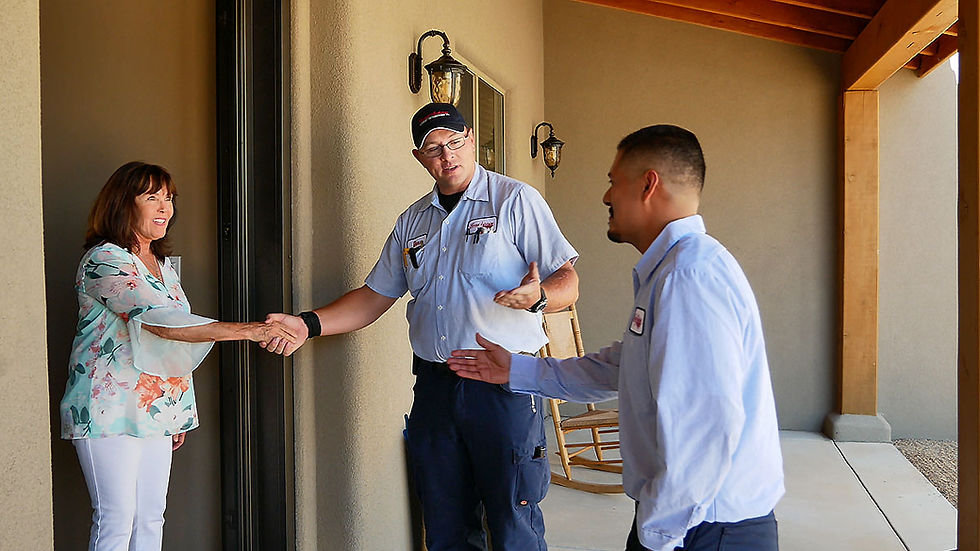Do You Have Hot Water Problems
- Forrest Anderson
- Feb 22, 2022
- 3 min read
On a cold morning, not much feels better than a hot shower. When the air temperature drops, it takes forever for the water temperature to increase. You turn on the shower, grab your clothes, brush your teeth, and make the bed, yet the water has just warmed up. Why is that? Do you have hot water problems?

There are four main reasons your hot water could be running slowly:
The distance between the heater and the final destination
The diameter of the pipe
Flow rate of the fixture
How much heat the cold pipes siphon off during the water’s journey
Length of Pipes
Unlike architecture, plumbing doesn’t follow a set structure. Instead, the layout is at the whim of the installer. Your water could have quite the journey from the water heater to your faucets.
While your home may not even be that big, it’s a more direct route for you to walk from the heater to the bathroom than for the pipes to travel through the walls. So if it’s 30 feet for you, it might be 50 feet for the pipes.
Diameter of Pipes
Two variables determine the speed at which water flows from the heater to its destination: the amount of water and pipe diameter. And that flow rate is usually determined by the flow rate of the faucet of the fixture.
For the speed of the water, the building codes limit water velocity in the piping. The limit is set from five to eight feet per second to prevent erosion of the pipe and fittings.
Let’s say you set your water for 40 psi, and you have ½” diameter copper pipes that have 100 feet to cover. The water would have a flow rate of higher than six gallons per minute and a velocity of more than 10 feet per second.
That means it will take five seconds for hot water to reach your shower, which is fast!
However, old pipes may not be quite as efficient, and you’re left waiting minutes instead of seconds for a hot shower.
Flow Rate at the Fixture
The flow rate of bathroom sink fixtures is limited to one gallon per minute or less.
Showerheads run at one gallon per minute. If that’s the case, it will take your hot water 32 seconds to travel through 50 feet of pipes.
The Federal Energy Policy Act of 1992 required all faucet and shower fixtures to have a flow rate of no higher than 2.2 gallons per minute at 60 psi. The pipes have a higher flow rate, but the fixture flow rate limits water velocity.
Heat Siphoned by Cold Pipes
During the winter, pipes are just going to be colder and absorb the heat from your water. The slower the heat travels and the heavier the pipe material, the more heat absorbed.
This is why it feels like hot water takes forever to get to where you want it during the colder months. The time it takes for hot water to travel to the fixture can easily double due to the heat loss in the pipes.
So How Do You Get Hot Water Faster?
The fastest way to increase the speed of your hot water would be to install a recirculation system.
If you’re experiencing a delay in getting hot water to your sink or shower, contact the plumbing experts at Forrest Anderson. We can troubleshoot issues and provide some solutions that might work for your unique situation.
Contact Forrest Anderson Today!




Choosing skor88 login provides users with confidence that accounts are protected. Strong verification systems reduce risks while maintaining speed. The platform’s balance of security and ease of access makes it ideal for users who prioritize both safety and convenience. skor88 login
Feel safe, confident, and satisfied with discreetly packaged pune sex toys. High-quality, body-safe materials ensure both pleasure and peace of mind. No judgment, no awkward moments—just pure, private fun delivered right to your doorstep. Pune’s most trusted intimate shopping experience is just a click away.
Foster-to-adopt programs enable families to first foster a child with the possibility of adoption. This approach allows families and Giving a child up for adoption children to build a bond before making the permanent legal commitment. It also provides stability for children who have been in the foster care system.
During the treatment, a laser emits a light that is absorbed by the pigment in the hair. This light energy is converted pcdc fat dissolving into heat, which damages the hair follicle. The damage prevents the follicle from producing new hair, leading to long-term hair reduction.
Dealing with hot water problems can be quite a hassle! If your water heater is acting up or needs replacement parts, sometimes it’s worth considering alternative sources for affordable options. I noticed that https://www.autobidmaster.com/en/locations/usa/texas/tx-lufkin/ offers a range of salvage and used items, including vehicles and potentially useful parts. While they primarily focus on cars, you might find some compatible components for your heating system or even other useful items for your home repair projects. It’s always good to have more options, especially when dealing with unexpected issues like this. Has anyone else tried sourcing parts from there?